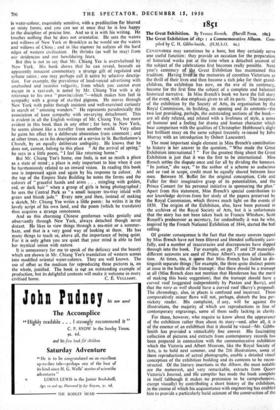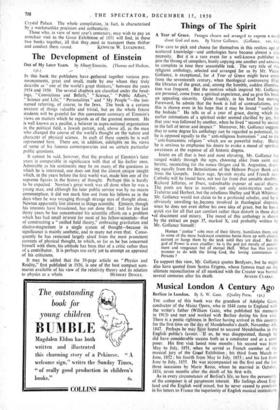1851
CENTENARIES may sometimes be a bore, but they certainly serve one useful function: they provide an occasion for the preparation of historical works just at the time when a detached account of the subject of the celebrations first becomes really possible. Next year's centenary of gie Great Exhibition has maintained this tradition. Having liveein the memories of countless Victorians as the thrill of their lives and then become a rich joke for their grand- children, the exhibition has now, on the eve Of its centenary, become for the first erne the subject of a complete and balanced historical narrative. In Miss ffrench's book we have the full story of the event, with due emphasis given to all its parts. The inception of the exhibition by the Society of Arts, its organisation by the Royal Commission, its building, its opening and its contents—the two last providing, perhaps, the outstanding sections of the book— are all duly related, and related with a liveliness of style, a sense of humour and a feeling for drama and human character which bear comparison with the qualities of Christopher Hobhouse's slight but brilliant essay on the same subject (recently re-issued by John Murray with an introduction by.Osbert Lancaster).
The most important single element in Miss ffrench's contribution to history is her answer to the question, "Who made the Great Exhibition international ? " For the greatest thing about the Great Exhibition is just that it was the first to be international. Miss ffrench settles the dispute once and for all by dividing the honours. "In justice," she says, "to the author of a scheme so audacious and so vast in scope, credit must be equally shared between four men. Between M. Buffet for the original conception, Cole and Fuller for their imaginative grasp of its potentialities, and the Prince Consort for his personal initiative in sponsoring the plan." Apart from this statement, Miss ffrench's special contribution to our knowledge derives.from her study of the papers preserved by the Royal Commission, which throws much light on the events of 1850. The origins of the Exhibition, also, have been pursued in the archives of the Royal Society of Arts, but it is unfortunate that the story has not been taken back to Francis Whishaw, Scott Russell's predecessor as secretary, for undoubtedly it was he who, inspired by the French National Exhibition of 1844, started the ball rolling.
Of greater consequence is the fact that the many sources tapped by Miss ffrench have not been filtered and blended sufficiently care- fully, and a number of inaccuracies and discrepancies have slipped through into the book. For example, on pp. 57 and 129 materially different accounts are used of Prince Albert's system of classifica- tion. At times, too, it spems that Miss ffrench has failed to dis- tinguish separate things --Tor example, the three quite distinct points at issue in the battle of the transept : that there should be a transept at all (Miss ffrench does not mention that Henderson has the merit of making this basic suggestion), that the transept should have a curved roof (suggested independently by Paxton and Barry), and that the nave as well should have a curved roof (Barry's proposal). The chronology, also, in places is confused and incorrect. These comparatively minor flaws will not, perhaps, disturb the less per- nickety reader. His complaint, if any, will be against the illustrations, the majority of Which are reproductions in line of contemporary engravings, some of them sadly lacking in clarity.
For those, however, who require to know about the appearance of the exhibition rather than about its story—and, after all, it is of the essence of an exhibition that it should be visual—'M r. Gibbs- Smith has provided a remarkably fine answer. His fascinating collection of pictures and extracts from contemporary records has been prepared in connection with the commemorative -exhibition which the Victoria and. Albert Museum, like the Royal Society of Arts, is to hold next summer, and the 216 illustrations, some of them reproductions of actual photographs, enable a detailed visual conception of the exhibition building and its contents to be recon- structed. Of the literary insertions in the Album, the most notable are the numeroA and very remarkable, extracts from Queen Victoria's Journal, and die compiler has made the book complete in itself (although it makes no pretension to be comprehensive, except visually) by contributing a short history of the exhibition, in the course of which his acquaintance with engineering has enibled him to provide a particularly lucid actount of the construction of the Crystal Palace. The whole compilation, in fact, is characterised by a workmanlike precision and authenticity. Those who, in view of next year's centenary, may wish to pay an armchair visit to the Great Exhibition of 1851 will find, in these two books together, all that they ,.need to transport them thither







































 Previous page
Previous page